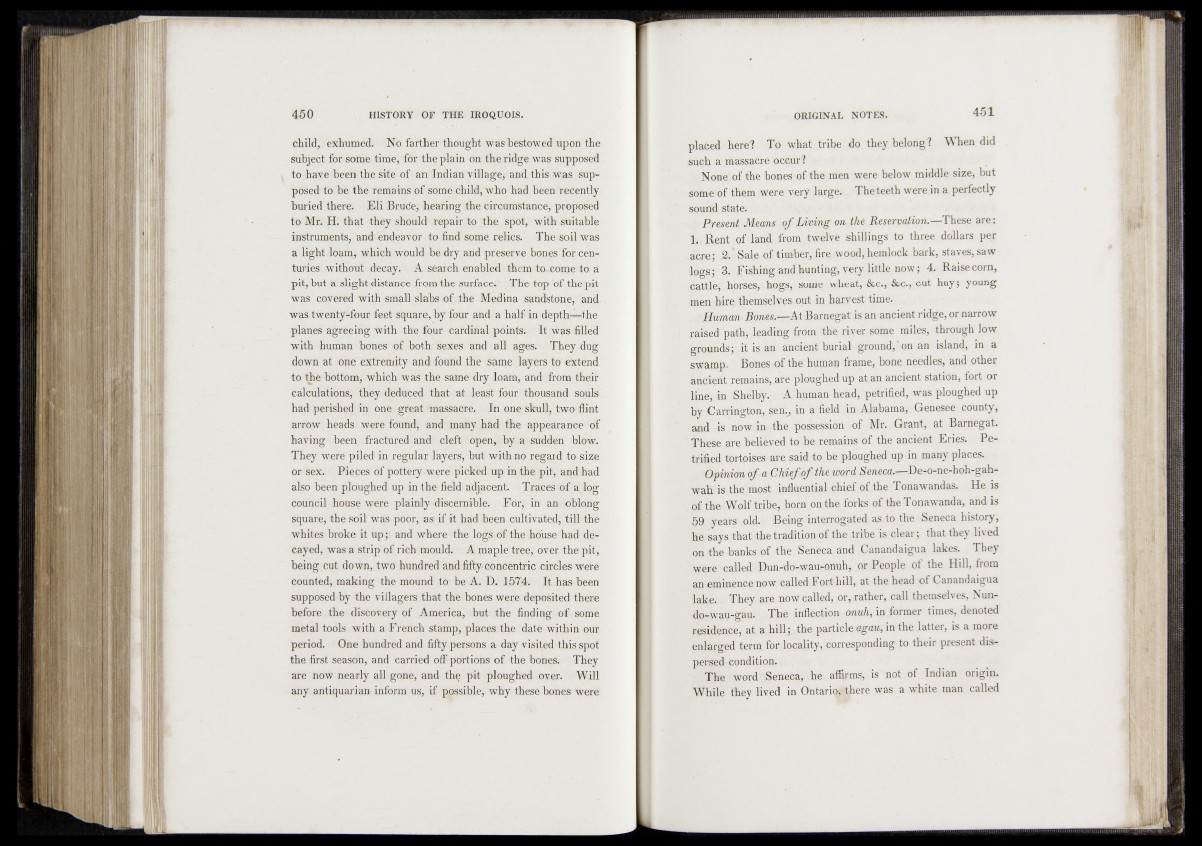
child, exhumed. .No farther thought was bestowed upon the
Subject for some time, för the plain on the ridge was supposed
i to have been the site of an Indian village^ and this -was supposed
to hè the remains of .some child, who had been recently
buried there. Eli BrilOe, hearing the circumstance, proposed
to Mr. H. that they sbptild repair to the spot,’* with suitable
instruments, and Endeavor torfind some reKcs. The soil was
a light loam, which would be dry and preserve bon^s'for, oen-
turies without decay. A search enabled them-tcueome to a
pit, but a slight distance from the surfaced The top of the pit
was covered with small slabs óf dhe Medina sandstone, .and
was twentyrfour feet square, by four and a half in depth-!—the
planes agreeing with the four cardinal points., It was filled
with human bones of both sgXeS and all ages. They dug
down at one extremity and found the same layers to extend
to the bottom, which was the same dry loam^and.from their
calculations, they deduced that at least four .thousand souls
had perished in one great ^massacre. . In one- skuB, two Bint
arrow heads were fouiid, and many had the appearatfee^of
having- been fractured and cleft, open,.by a-Süddeh Blow.
They were piled in regular layers, but with no regard tasjze
or sex. Pieces óf pottery «were picked, up in the pit, and had
also been ploughed up in the field adjacent. *-Traces^of a^tog
cpulicil house were plainly discernible. For, in an ofeMng
square, the soil was poor, as if it had been cultivated, till the
whites broke it up; and where the logïfofVthe house had decayed,
was a strip of rich mould, A maple'-treey ov.er the pit,
being cut down, two hundred and fifty concentric .circles were
counted, making the mound .to' be A. D. 157.4. v.lfc has been
supposed by the villagers that the bones were deposited there
before the discovery of America, hut the .finding of some
metal tools with a French stamp, places the date within our
period. One hundred and fifty persons a day visited this spot
thé first season, and carried off portions of the bones. They
are now nearly all gone, and the pit ploughed over. Will
any antiquarian inform us, if possible, why these bones were
placed here? To what* tribe do they belong 1 When did
iqch a ;massacre occur 1' -
* None of the hones'of the men were below middle size, hut
some of them were very large. Theteeth were in a perfectly
sound state.
Present Means*of Living on tfie Reservation.—These are:
L.Rent icf land, from twelve shillings to three dollars per
j§ apre; 2-.* Sale of timber, fire wood, hemlock bark, staves, saw
•logs;. 3. Fishing and hunting, very little now; 4. Raise corn,
.Cattle;,horses;' hogs, some wheat, &c.j &c.jiCut hay; young
men hirefhemsclves out in harvest time.
. Human Rimes. B a r n e g a t is an ancient ridge, ormarrow
raised’path, leading from the river some miles, through low
grounds; it Is .an ancient burial ground,‘on an island, in a
swamp. Bones of the humaq frame, bone needles, and other
aficiqm T^m'ains,:are ptoogheef-hp at an ancient station, fort or
line, in Shelby.^ A human head, petrified, was ploughed up
by -Carrington, sen;, in a field in Alabama;, Genesee county,
and is. now in. the..possession--.of .Mr. Grant, at Barnegat.
These are believed to" be remains of the ancient Eries; Petrified
tortoises are said to be. ploughed up in many places.
Opinion o f a- Chief p f th,e wopd Seneca.—De-o-ne-hoh-gah-
waliis the most influential chief Of .the Tonawandas. He is
theWolf tribe,,(hqrB;pn:the forks of theTonawanda, and is
59 years old.. ‘Being interrogated as to the Seneca history,
he says that the tradition of the tribe is clear; that they lived
out the banks o f the Sefieca and Canandaigua lakes. They
Were, called Jhm-do-waUrPnuh, pr People of the Hill, from
ap-eminenCe now called Fort hill,; at the head of Canandaigua
lake.-. They are now called* or, rather, call themselves, Nun-
do-wau-gaq»^ The inflection onuh, in former times, denoted
residence, at a hill.;,the particle agau, in the latter, is a more
enlarged term for locality, corresponding to their present dis-
’ persed-condkiohi a
The word *:Seneca, he affijmvis not of Indian origin.
While they lived in Gntariofifoere was a white man called